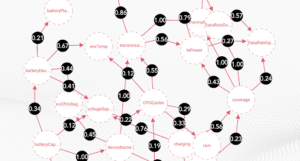- Services
Technology Capabilities
Technology Capabilities- Product Strategy & Experience DesignDefine software-driven value chains, create purposeful interactions, and develop new segments and offerings
- Digital Business TransformationAdvance your digital transformation journey.
- Intelligence EngineeringLeverage data and AI to transform products, operations, and outcomes.
- Software Product EngineeringCreate high-value products faster with AI-powered and human-driven engineering.
- Technology ModernizationTackle technology modernization with approaches that reduce risk and maximize impact.
- Embedded Engineering & IT/OT TransformationDevelop embedded software and hardware. Build IoT and IT/OT solutions.
- Industries
- GlobalLogic VelocityAI
- Insights
BlogsNovember 6, 2023GlobalLogicOntology – key Enabler of Next-Gen Technologies
Every big or mid-sized company has a proliferation of sites, edge devices, apps, and di...
 BlogsNovember 30, 2023GlobalLogic
BlogsNovember 30, 2023GlobalLogicSmartphone on Wheels
Over the past decade, cars have undergone a significant transformation to provide a mor...

- About
Published on November 6, 2023Ontology – key Enabler of Next-Gen Technologies
ShareRelated Insights Yuriy Yuzifovich4 March 2025
Yuriy Yuzifovich4 March 2025 GlobalLogic26 February 2025View All Insights
GlobalLogic26 February 2025View All Insights GlobalLogic26 February 2025
GlobalLogic26 February 2025Let's start engineering impact together
GlobalLogic provides unique experience and expertise at the intersection of data, design, and engineering.
Get in touchAI GovernanceMLOpsTechnologyEvery big or mid-sized company has a proliferation of sites, edge devices, apps, and different technologies for managing and scaling their business. These systems generate plenty of structured and unstructured data. Industries are investing billions of dollars in digital transformation, but the actual value is not being extracted from these data. Cutting-edge technologies like Artificial Intelligence (AI) and Machine Learning (ML) would only serve their purpose when we have properly defined and cleaned data as per business requirements. Principally, companies operate with different structures of data, where some go missing, and some are not accurately organized. This is where Ontology helps us define the comprehensive structuring and definition of data.
Ontology provides a shared vocabulary and set of rules for representing and manipulating data. It also helps in enabling seamless communication and integration between different systems, once the concepts and relationships with the advanced technologies are well defined. It plays a key role in the development of AI applications, as it allows the representation and manipulation of knowledge in a structured and logical way. The ontology allows AI systems to reason about and makes decisions based on complex and nuanced information. In the context of the IoT, ontology allows the integration and interoperability of different devices and sensors. Here, ontology enables the seamless exchange of information between these devices and the integration of their data into larger systems.
Ontology is also an important enabler in the development of blockchain technology. Blockchain relies on a decentralized and distributed ledger to store and validate transactions, and ontology provides a framework for defining the concepts and relationships between different entities and transactions in the ledger. This enables the creation of smart contracts and other applications that rely on the accuracy and integrity of the data stored in the blockchain.
Building Blocks of an Ontology
There are different types of ontologies such as task, domain, and upper level. Building an ontology that makes sense out of all your company data is not an easy task, rather, it requires a lot of assessments, experience around use cases, and learnings from past failures and so on.
- Identify Enterprise use cases – An enterprise would have multiple domains and areas where different use cases exist. We should capture our past experiences to identify failures and try to address those using ontologies.
- Understand data and its availability – Once use cases are identified we should identify all those related data pointers which are required to solve these use cases. Missing data or bottlenecks need to be captured and provisioned, such that it helps us in designing our knowledge graphs.
- Craft solution for the root cause – Once data is available for the defined use cases, we should revisit the root cause of the problems, and create the data architecture such that it defines mature and connected knowledge graphs for reducing the overall timing which would help us in monetizing the data and benefit our business.
- Maintenance plan for Ontologies – Ontologies are not a one-time activity, rather, it should be constantly matured, so that it is up to date with all the latest information.
Why is its adoption slow?
So, now the question arises, if ontology is indeed so critical for any business – then why is its adoption slow? Well, every organization’s primary focus is the advancement of their technologies and then their processes. Maintaining multiple domain-specific entities and their relationship is a cumbersome task and requires continuous effort. Another factor could be the copious amounts of interaction within groups of the same domain. In addition, the benefits of the ontology may not always be immediately apparent, and the return on investment may not be clear, making it difficult to justify the expenditure to decision-makers. This is often a major reason for the slow adoption of ontology.
What its future look like?
Data is exploding for all kinds of enterprises. Developing a proper understanding of the data is a complicated, and time-consuming task. Developing ontologies will help us in a prompt understanding of a domain and accelerate the evolutionary process. One thing is clear that AI is going to help us automate many problems, for example – customer service chatbots, alerts about system glitches, business efficiencies, any root cause analysis, and many more. If AI is the future of any enterprise business, then creating an ontology is essential to prepare the business to attain those benefits in the future.
Ontology plays a crucial role as an enabler of next-generation technology, providing a foundation for the integration and interoperability of different systems and enabling the representation and manipulation of complex and nuanced information. Its importance will only continue to scale as these technologies continue to advance and become more prevalent in our daily lives.
